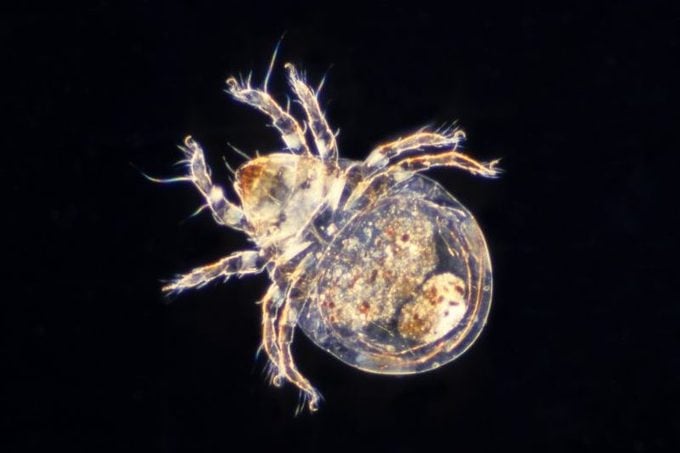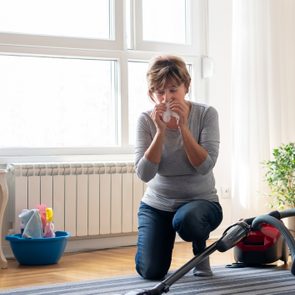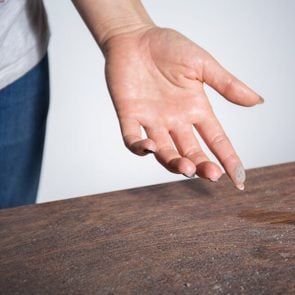Do Dust Mites Bite?
Updated: Mar. 08, 2022
Dust mites may be responsible for sneezing, sniffling, and watery eyes if you are allergic, but do these tiny critters bite or cause a rash? Experts explain.
Do dust mites bite?
First, the good news: dust mites don’t bite.
Yes, contact with them can cause sniffling, sneezing, wheezing, and watery eyes if you are one of the 20 million people unlucky enough to be allergic to these ubiquitous, microscopic mites. However, they don’t bite.
They also don’t fly or spread disease, adds Zachary DeVries, PhD, an assistant professor of entomology at the University of Kentucky in Lexington.
Here’s what you need to know about dust mites, rashes, and more.

What are dust mites, anyway?
Dust mites are members of the arachnid family, just like spiders, chiggers, and ticks. These white spider-like critters have eight legs and are so tiny that they are only visible via microscope. Just how small? About 0.1–0.4 millimeters long, DeVries says.
They tend to live wherever you find dust: your bed, couch, pillows, carpets, stuffed animals—you name it.
There are many species of dust mites, but the two most common ones in the United States are the North American house dust mite, Dermatophagoides farinae, and the European house dust mite, D. pteronyssinus.
(Who is sleeping in your bed? Is it a dust mite or a bed bug? Here’s how to know for sure.)
Dust mites life partly off of the dead skin cells people shed in abundance every day, and dead skin cells can be found in dust. (The average adult sheds up to 1.5 grams of skin a day, which can feed 1 million dust mites.)
“Unlike other insects which are parasites, dust mites only kind of need us,” he says. They don’t drink water either. Instead, they absorb it from the environment. The less humidity in your air, the less likely they are to set up camp, he says.
Dust mites by the number
A dust mite’s life cycle comprises five stages: egg, larva, protonymph, tritonymph, and adult.
This transition takes about one month, provided conditions are optimal, and adult dust mites can live up to two months. Female dust mites can lay up to 100 eggs, according to the entomologists at the University of Kentucky in Lexington.
Brace yourself: there can be as many as 1 million dust mites in a mattress, DeVries says. And there can be as many as 18,000 dust mites in each gram of dust. That’s a whole lot of mites.
How to spot a dust mite reaction
So, if dust mites don’t bite, just how can they cause symptoms or reactions?
“Dust mites cause allergy by inhalation of their microscopic fecal matter and dead body parts, which are allergens,” explains says Neeta Ogden, MD, and allergist and immunologist in Edison, New Jersey, and an American College of Allergy, Asthma, and Immunology (ACAAI) spokesperson.
A house dust mite can produce about 2,000 fecal pellets in 10 weeks, notes the Indoor Air Quality Association.
This may lead to year-round nasal congestion, she says. “Eczema, which is allergic, itchy skin eruptions, and allergic asthma are also tied to dust mite allergy.”
So although dust mites don’t bite, they can cause skin rashes and exacerbate atopic dermatitis, the most common type of eczema. This itchy skin condition is linked to allergies, including dust mite allergies.

Dust mite prevention
Controlling dust mites in your home can improve these symptoms, Dr. Ogden says.
It’s near impossible to get rid of all of the dust mites in your home, but you can make a big dent if you do the following.
Wash your sheets regularly
Wash your sheets in hot water and a hot dryer cycle once a week.
This will kill off residual dust mite particulate matter, Ogden says. If the item isn’t washable, place it in a Ziploc bag and put it in your freezer for two days to freeze mites to death, DeVries adds.
Cover what you can
Use allergen encasings to cover your mattresses, pillows, and box springs, she suggests. These minimize exposure to dust mites.
Keep up with vacuuming
Vacuum regularly with a high-efficiency particulate air (HEPA) filter, Ogden says. If you are not using a HEPA filter, your vacuum could spit dust mites back into the air around you. (These are the best HEPA filter vacuums if you have allergies.)
Consider investing in a HEPA filter, which can be found in a portable air purifiers that you can take from room to room. This helps clear the air of dust mites and other potential allergens, Ogden says.
Clean when you can
Keep your home clutter-free so dust mites don’t stand a chance, she adds. (Here are products will also help you get rid of dust mites.)
Wipe down surfaces frequently so dust can’t accumulate.
Opt for less fabric
Avoid fabric drapes and headboards, which can harbor mites, Ogden advises. Instead, opt for blinds, she says.
“Same thing with flooring—hard surfaces that can be cleaned better than wall-to-wall carpet; use rugs that can be regularly thrown in the wash,” she adds.
Tone down the temperature
Lower the humidity around your home to below 50 percent, as dust mites need humidity to survive, DeVries says. They also need temperatures of 68 to 77 degrees Fahrenheit (20 to 25 degrees Celsius) to thrive, he says.
Dust mite allergy diagnosis and treatment
The best way to find out what is causing your allergy symptoms, such as sneezing, wheezing, and itchy eyes, is to see an allergist for further testing.
Skin prick and/or blood testing can help figure out if dust mites are responsible for your misery. Your doctor will also ask questions about your symptoms and when they are most likely to occur to help identify what is driving them.
If dust mites are the culprit, allergy shots or immunotherapy can make a big difference in your symptoms, says Russell Leftwich, MD, an allergist in Nashville, Tennessee, and an American Academy of Allergy, Asthma & Immunology spokesperson.
These shots (or oral drops) work by slowly introducing dust mite allergens to your immune system so that they will be familiar enough with them and won’t launch an attack.
Other over-the-counter or prescription treatments target specific symptoms of dust mite allergy. If you’re stuffy, a nasal spray or oral antihistamine can help, while eye drops may soothe eye irritation, Dr. Leftwich says.
Next, check out these other common indoor allergen triggers.























